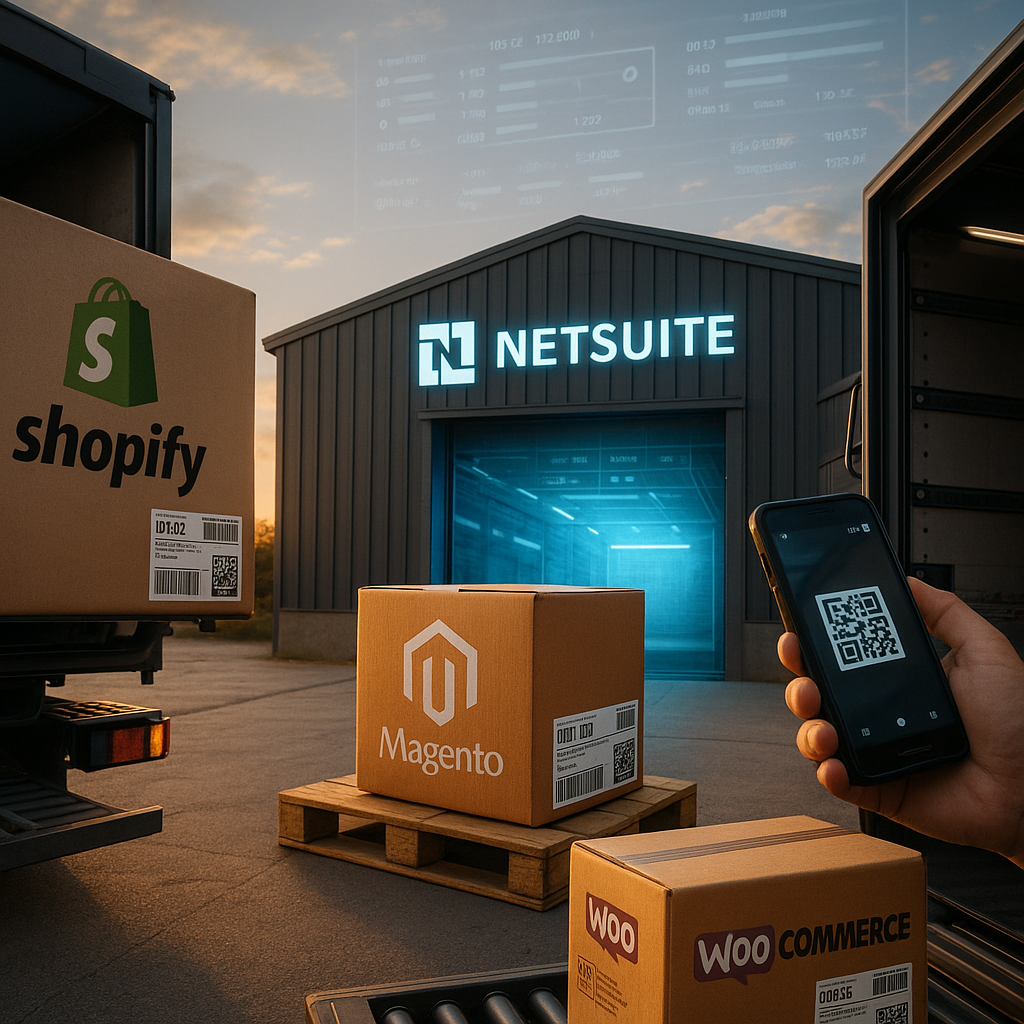9 min read
NetSuite E‑Commerce Integration: How to Connect Shopify, Magento, or WooCommerce
Are you living with slow order processing, mismatched inventory counts, and frustrated customers because your store and your ERP don’t...
10 min read
Ritch Haselden : Oct 14, 2025 11:30:00 AM

Are you still patching together finance, operations, and reporting across multiple systems and feeling the strain every quarter-end? If your CFO role or owner’s oversight is being consumed by data wrangling instead of strategy, you might be on the cusp of outgrowing your ERP system.
According to Oracle NetSuite, 50% of companies are actively upgrading or replacing their ERP systems to keep up with growth and complexity. In other words, half of your peers have already realized that legacy solutions no longer cut it at scale.
In this article, you’ll learn how to spot the 8 clear signs it’s time to upgrade or replace your legacy ERP system, and why NetSuite is often the scalable, future‑proof ERP solution that growing businesses trust.
At some point, every growing business outpaces the systems it started with. If you're relying on outdated ERP software, manual reports, or disconnected tools, you’re already feeling the drag. NetSuite offers a modern ERP system that helps businesses move from patchwork processes to a centralized platform that scales.
Unlike on-premises ERP systems or small-business solutions like QuickBooks, NetSuite is a cloud-based ERP built for flexibility, speed, and long-term growth. It integrates your financials, CRM, inventory, procurement, and more, so you can scale without breaking your core systems.
Old ERP systems require constant upgrades, hardware upkeep, and hands-on IT support. NetSuite replaces that with a cloud-based ERP solution that handles updates automatically, improves uptime, and ensures security across all your locations. You don’t need to invest in infrastructure every time you grow.
NetSuite’s architecture is designed to support multiple entities, currencies, and tax rules in one system. Whether you're expanding into new regions or rolling up new acquisitions, the system stays stable while your business evolves.
If your teams still wait days for reports or rely on spreadsheets to close the books, your ERP system is already too slow. NetSuite offers real-time dashboards and live reporting across departments, allowing decision-makers to act on accurate data the moment they need it. CFOs no longer chase down data. Business owners gain instant visibility into performance, forecasts, and trends—no IT handoffs or manual pulls required.
Switching ERP systems often means pulling out years of bolt-on fixes and workarounds. NetSuite simplifies this transition. It natively integrates core functions like accounting, inventory, procurement, CRM, and e-commerce.
That means fewer data silos, faster processing, and a system that actually works together instead of against itself. With one ERP platform, teams can stop reconciling reports and start executing.
Your ERP solution should never limit your growth. NetSuite adapts to new product lines, business units, and revenue models with ease. It supports custom workflows, recurring billing, complex pricing structures, and more, all without needing a custom rebuild. As your operations become more complex, NetSuite scales up, not sideways. You stay focused on strategy while the platform handles the logistics.
Legacy ERP systems often feel like a burden. They're expensive to maintain, slow to adapt, and unsupported by modern vendors. NetSuite provides a clear path forward. No more surprise update fees, version compatibility issues, or patchwork fixes.
Companies that upgrade to NetSuite reduce IT overhead, accelerate close cycles, and eliminate the chaos of working across disconnected systems. If your ERP system is more of a liability than a tool, it's time to upgrade.
Every ERP system has a shelf life. What supported your business five years ago may now be slowing you down. If your ERP software can't adapt to your current complexity, that's not just a technology issue. It's a business risk. These are the clearest signs you need to upgrade your ERP.
If your teams rely on spreadsheets to close the books, track inventory, or manage billing, your ERP system may be reaching its limits. Manual processes eat into productivity and increase the risk of costly errors. More critically, they prevent your finance and ops teams from focusing on strategic work.
A modern ERP solution should automate core functions like journal entries, approvals, and reconciliations. If that sounds like a new ERP dream rather than your current ERP reality, it’s time to consider an ERP upgrade.
Outdated ERP systems often deliver financial or operational data days, or even weeks, after it's needed. By the time a report is ready, the data is stale and the decision window is gone.
If your business needs real-time visibility into cash flow, revenue, or inventory but your existing ERP software doesn’t provide it, that’s a clear sign you need to upgrade your ERP system. Modern cloud-based ERP systems like NetSuite offer dashboards and live metrics CFOs can trust.
A common sign that it’s time to upgrade your legacy ERP is when it can't connect with the rest of your tech stack. Whether it's CRM, e-commerce, payroll, or analytics, disconnected tools cause duplicate data, inconsistent reporting, and operational drag.
If integrating new software requires expensive custom development or vendor workarounds, your system is holding your business hostage. Switching ERP systems to a cloud-based ERP solution that integrates natively isn’t just an IT move. It’s a business enabler.
As your operations expand, so do your regulatory obligations. Legacy ERP systems often lack automated audit trails, user-level access controls, or configurable workflows. These gaps increase risk, especially when operating across regions or industries.
If your current ERP system forces you to manually track compliance or scramble for audits, it’s no longer supporting your business. It’s exposing it. A new ERP system with built-in governance tools can reduce risk and cut prep time in half.
Older ERP versions often lose vendor support, forcing businesses to rely on outdated software that lacks patches, integrations, or scalability. If your ERP vendor is no longer updating your platform or you’re stuck on an aging, on-premises ERP with limited cloud options, you’re gambling with security and continuity.
This is one of the most overlooked signs you need to upgrade. A supported, cloud-based ERP ensures you have access to the latest features, security protocols, and compatibility updates.
Growth shouldn't require rebuilding your backend. But if opening a new location, launching a new product line, or entering a new market means reconfiguring your entire ERP system, then it’s not built to scale. Flexible ERP systems allow you to adapt quickly, without overhauling architecture or launching new ERP implementations for every business change.
If you're using five tools to do the job one ERP system should handle, your operational costs and complexity are out of control. Many businesses fall into the trap of bolting on workarounds to stretch a legacy ERP solution. This leads to redundant data, version conflicts, and costly inefficiencies.
Consolidating to one robust ERP system reduces IT overhead, improves data quality, and streamlines day-to-day operations.
Perhaps most critically, if your ERP technology no longer aligns with your growth plans—whether that’s international expansion, M&A activity, or new business models—it’s a major red flag. Enterprise resource planning should support your strategy, not restrict it.
If your current ERP system limits what you can do, it’s time to replace it with a flexible, cloud-based ERP platform that’s built to support where you're going next.
Upgrading your ERP system isn’t just about modernizing software—it’s about enabling your business to grow without structural breakdown. The most successful ERP transitions happen when leadership recognizes the early signs. Waiting too long can result in missed opportunities, rising costs, and systems that can no longer support your strategy.
If your existing ERP is slowing innovation, failing to scale, or leaving visibility gaps, it may be time to evaluate NetSuite as your next solution.
Scaling geographically or across legal entities exposes the cracks in older ERP solutions. Legacy systems often require manual work to consolidate financials, support multiple currencies, or navigate tax structures. NetSuite, as a cloud-based ERP system, handles multi-entity management, global consolidations, and real-time compliance in one centralized platform.
If international growth feels like a tech project instead of a business milestone, it’s a sign you need to upgrade your legacy ERP.
M&A activity introduces complexity fast. Multiple ERP systems, duplicate records, and siloed reporting make it difficult to get a unified view of your business. A modern ERP solution like NetSuite replaces fragmented systems with a single source of truth, giving you control during the most volatile transitions.
When integration speed matters, switching ERP systems to a scalable, cloud-based platform becomes a strategic advantage.
What worked for a $1M company will fail at $10M. Businesses running on QuickBooks, Xero, or other basic accounting tools eventually reach a point where transaction volumes, user counts, and reporting demands break the system.
NetSuite is designed to replace a legacy ERP system or entry-level platform before breakdowns happen. Its modular structure and real-time automation eliminate the bottlenecks that slow down high-growth companies.
Your ERP system should enable innovation—not block it. If your current ERP lacks the flexibility to support subscriptions, usage-based billing, e-commerce, or marketplace integration, it's time to replace your ERP system with a modern platform that can.
NetSuite supports recurring billing, multi-channel sales, and advanced order orchestration. It adapts without requiring full reimplementation every time your business evolves.
Investors scrutinize financial integrity. Outdated ERP systems don’t offer the audit trails, controls, or reporting precision required for serious capital events. If you're approaching an investment round, private equity acquisition, or IPO, your ERP technology must keep up with the demands.
NetSuite provides audit-ready reporting, built-in compliance features, and system reliability that signals maturity to stakeholders. If you’re planning a major system transition ahead of an IPO or investment round, review our NetSuite Implementation Cost & Timeline Guide to understand the time and budget considerations of an ERP upgrade.
If you're hitting any of these points, you're not just facing growing pains—you’re facing real reasons to upgrade your ERP system. Whether you're replacing your ERP due to expansion, complexity, or opportunity, NetSuite offers the flexibility and scale to support you moving forward.
It’s not just time to upgrade. It’s time to upgrade smart.
Every day you postpone an ERP upgrade, the cost of inaction quietly compounds. What starts as an inconvenience—like exporting data manually or fixing broken reports—can escalate into systemic risk. If your current ERP system is outdated, unsupported, or fundamentally misaligned with your business model, the consequences go beyond IT. They hit your bottom line, your teams, and your future growth.
When your ERP software lacks automation, finance teams are forced into time-consuming, manual processes. Month-end close drags on. Labor costs climb. Budget forecasts become guesswork. Outdated systems don’t provide the real-time accuracy needed to steer confidently.
These inefficiencies aren’t just annoying. They erode margins over time. Delaying an ERP upgrade means choosing short-term convenience over long-term performance.
Disconnected systems create duplicate records, conflicting reports, and manual entry errors that compromise decision-making. Legacy ERP software often lacks the validation controls, integrations, and support updates that protect data across platforms.
If you're already encountering these issues, our NetSuite Troubleshooting Guide offers practical insights for identifying and resolving common ERP problems. As your business grows more complex, poor data quality becomes a liability. If you’re using your ERP and still second-guessing your numbers, it’s time to evaluate a new ERP system.
A rigid or aging ERP system often can’t support new business models, revenue channels, or geographic expansion. Whether it’s launching e-commerce, entering new markets, or consolidating entities, your current software may be holding you back without you realizing it.
ERP systems are designed to scale, but only if they’re modern. Legacy systems can’t adapt fast enough to capitalize on opportunities. If your ERP can’t evolve with your strategy, you’re already behind.
When systems break down, people have to pick up the slack. Teams that use multiple systems, build workarounds, and manage endless spreadsheets experience burnout. Turnover increases, institutional knowledge disappears, and morale drops.
An ERP project should support your team, not force them to create one-off solutions. If your people are doing what your platform should be handling, that’s a sign you need to upgrade your ERP.
ERP systems don’t just age—they decay. Vendors sunset support. Software versions become obsolete. Integrations break. The longer you delay, the harder and more expensive it becomes to migrate to a newer ERP.
Implementing an ERP system on your terms is always cheaper than rushing one in a crisis. Time is money, and waiting until the system no longer functions is a gamble that rarely pays off.
If your current ERP system is straining under growth, complexity, or performance demands, that’s not a signal to wait. It’s a signal you’re ready to upgrade. Don’t wait for a breakdown to force your hand—switch to a cloud-based ERP solution that’s equipped to support you moving forward.
A successful ERP upgrade is more than just replacing software. It’s about aligning people, process, and technology to future-proof your business. Whether you're switching ERP systems from a legacy solution or implementing a new ERP system for the first time, follow these steps to maximize your ROI and minimize disruption.
Start with a clear-eyed audit of your existing ERP. Which processes are broken? Which reports take too long? Where do integrations fail? Understanding these limitations helps define what your new ERP solution must fix and what to avoid repeating.
This isn’t just about features. It’s about finding the signs you need to upgrade your ERP and mapping them to business outcomes.
Not all ERP systems are designed the same. Outline the non-negotiables based on your growth plans, compliance needs, and internal capabilities. Your ERP selection process should prioritize scalability, ease of integration, and total cost of ownership.
If you plan to switch to a cloud-based ERP, ensure the platform is flexible enough to support you as your operations evolve. NetSuite meets these requirements out of the box.
Rushing a new system rollout creates chaos. Instead, phase your ERP upgrade with clear milestones for data migration, sandbox testing, training, and go-live. Include time for unexpected delays, especially when moving from a legacy ERP system with complex hardware and software dependencies.
NetSuite’s cloud-based ERP system allows for agile deployment, but success still hinges on preparation.
Don’t do it alone. Experienced ERP providers, such as Kimberlite Partners, bring industry-specific expertise, tested frameworks, and post-launch support. Learn more about Kimberlite’s NetSuite Implementation Services to see how they tailor deployments to real business needs.
They help tailor your new ERP system to your workflows, avoid common pitfalls, and deliver results faster. A poor vendor decision can derail your ERP project. The right one sets the stage for long-term success.
Even the best software fails without adoption. Your ERP system also needs buy-in from every department. Train users early. Communicate how the upgraded system supports their daily work. Provide feedback loops. This is where many ERP implementations stall. Not because of the tech, but because users weren’t ready to upgrade.
Your ERP project doesn’t end at launch. Once the system is live, audit what’s working and what needs refinement. Adjust permissions, rebuild dashboards, and expand automation. NetSuite is a robust ERP platform, but you’ll only unlock its full value through ongoing optimization and support. Remember: upgrading your ERP is a transformation, not a one-time event.
The ERP system you started with may no longer be equipped to support you moving forward. As your business scales, the cracks in legacy systems become cost centers that are slowing down decisions, overloading teams, and limiting strategic agility.
If you’re still relying on workarounds, outdated reports, or disconnected tools, it may be time to upgrade your ERP and shift to a growth‑ready platform. A modern ERP solution like NetSuite eliminates barriers. From real-time reporting to automated workflows and scalable architecture, NetSuite helps you move faster with fewer risks.
Technology alone doesn’t suffice; success hinges equally on selecting the right partner to guide your ERP selection, implementation, and optimization. Ready to future-proof your operations? Explore Kimberlite Partners’ NetSuite Implementation Services and start building a smarter, scalable ERP foundation today.

9 min read
Are you living with slow order processing, mismatched inventory counts, and frustrated customers because your store and your ERP don’t...

5 min read
Most NetSuite implementations don’t fail because of technical issues. They fail because users never adopt the system. According to Gartner, by 2027
As of 2025, the global ERP software market has surged to $70 billion, and it’s projected to nearly double to $136 billion by 2032, according to...